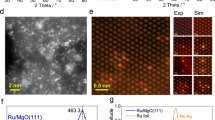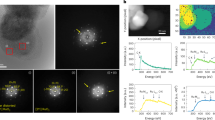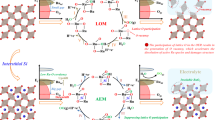Abstract
An efficient catalyst for the hydrogen oxidation reaction (HOR) must maintain an oxide-free metal surface in a relatively high potential range. This requirement automatically excludes ruthenium because it is susceptible to oxidation in the hydrogen adsorption/desorption potential region. Herein we report Ru clusters partially confined in the lattice of urchin-like TiO2 crystals (Ru@TiO2) that can effectively catalyse the HOR up to a potential of 0.9 VRHE with a mass activity higher than that of a PtRu catalyst under both acidic and basic conditions. Moreover, the HOR activity of this Ru@TiO2 catalyst is not affected by 1,000 ppm CO impurity. Even at a high CO content of 10 vol%, Ru@TiO2 still selectively catalyses the HOR. Confined Ru clusters grow along the lattice of TiO2 with abundant Ru–Ti bond formation. Such atomically connected co-crystals offer efficient electron penetration from electron-rich TiO2 to Ru metal, leading to sluggish CO adsorption kinetics during the HOR.

This is a preview of subscription content, access via your institution
Access options
Access Nature and 54 other Nature Portfolio journals
Get Nature+, our best-value online-access subscription
$29.99 / 30 days
cancel any time
Subscribe to this journal
Receive 12 digital issues and online access to articles
$119.00 per year
only $9.92 per issue
Buy this article
- Purchase on Springer Link
- Instant access to full article PDF
Prices may be subject to local taxes which are calculated during checkout







Similar content being viewed by others
Data availability
The data that support the findings of this study are available from the corresponding author upon reasonable request.
Change history
24 March 2021
A Correction to this paper has been published: https://doi.org/10.1038/s41929-021-00601-5
References
Cong, Y., Yi, B. & Song, Y. Hydrogen oxidation reaction in alkaline media: from mechanism to recent electrocatalysts. Nano Energy 44, 288–303 (2018).
Sheng, W. et al. Non-precious metal electrocatalysts with high activity for hydrogen oxidation reaction in alkaline electrolytes. Energy Environ. Sci. 7, 1719–1724 (2014).
Asazawa, K. et al. A platinum-free zero-carbon-emission easy fuelling direct hydrazine fuel cell for vehicles. Angew. Chem. Int. Ed. 119, 8170–8173 (2007).
Ohyama, J., Sato, T. & Satsuma, A. High performance of Ru nanoparticles supported on carbon for anode electrocatalyst of alkaline anion exchange membrane fuel cell. J. Power Sources 225, 311–315 (2013).
Shi, G. Y., Yano, H., Tryk, D. A., Watanabe, M. & Uchida, H. A novel Pt–Co alloy hydrogen anode catalyst with superlative activity, CO-tolerance and robustness. Nanoscale 8, 13893–13897 (2016).
Shi, G. Y., Yano, H., Tryk, D. A., Iiyarna, A. & Uchida, H. Highly active, CO-tolerant, and robust hydrogen anode catalysts: Pt–M (M = Fe, Co, Ni) alloys with stabilized Pt-skin layers. ACS Catal. 7, 267–274 (2017).
Ham, D. J., Kim, Y. K., Han, S. H. & Lee, J. S. Pt/WC as an anode catalyst for PEMFC: activity and CO tolerance. Catal. Today 132, 117–122 (2008).
Hydrogen Council. Hydrogen scaling up. https://hydrogencouncil.com/en/study-hydrogen-scaling-up/ (2017).
Davydova, E. S., Mukerjee, S., Jaouen, F & Dekel, D. R. Electrocatalysts for hydrogen oxidation reaction in alkaline electrolytes. ACS Catal. 8, 6665–6690 (2018).
Bellini, M. et al. Palladium–ceria catalysts with enhanced alkaline hydrogen oxidation activity for anion exchange membrane. Fuel Cells ACS Appl. Energy Mater. 2, 4999–5008 (2019).
Wang, R., Li, D., Maurya, S., Kim, Y. S. & Wu, Y. Ultrafine Pt cluster and RuO2 heterojunction anode catalysts designed for ultra-low Pt-loading anion exchange membrane fuel cells. Nanoscale Horiz. 5, 316–324 (2019).
Miller, H. et al. A Pd/C–CeO2 anode catalyst for high-performance platinum-free anion exchange membrane fuel cells. Angew. Chem. Int. Ed. 128, 6108–6111 (2016).
Yu, H. et al. Palladium–ceria nanocatalyst for hydrogen oxidation in alkaline media: optimization of the Pd–CeO2 interface. Nano Energy 57, 820–826 (2019).
Davydova, E., Zaffran, J., Dhaka, K., Toroker, M. & Dekel, D. Hydrogen oxidation on Ni-based electrocatalysts: the effect of metal doping. Catalysts 8, 454 (2018).
Obradovic, M. D. et al. The kinetics of the hydrogen oxidation reaction on WC/Pt catalyst with low content of Pt nano-particles. J. Electroanal. Chem. 671, 24–32 (2012).
Lu, S. Q. & Zhuang, Z. B. Investigating the influences of the adsorbed species on catalytic activity for hydrogen oxidation reaction in alkaline electrolyte. J. Am. Chem. Soc. 139, 5156–5163 (2017).
Hu, J., Kuttiyiel, K. A., Sasaki, K., Zhang, C. X. & Adzic, R. R. Determination of hydrogen oxidation reaction mechanism based on Pt–Had energetics in alkaline electrolyte. J. Electrochem. Soc. 165, J3355–J3362 (2018).
Sheng, W. C. et al. Correlating hydrogen oxidation and evolution activity on platinum at different pH with measured hydrogen binding energy. Nat. Commun. 6, 1–6 (2015).
Wang, L., Zhou, Y., Yang, Y., Subramanian, A. & Rafailovich, M. Suppression of carbon monoxide poisoning in proton exchange membrane fuel cells via gold nanoparticle/titania ultrathin film heterogeneous catalysts. ACS Appl. Energy Mater. 2, 3479–3487 (2019).
Liu, Z., Ling, X. Y., Su, X. & Lee, J. Y. Carbon-supported Pt and PtRu nanoparticles as catalysts for a direct methanol fuel cell. J. Phys. Chem. B 108, 8234–8240 (2004).
St. John, S. et al. Ruthenium-alloy electrocatalysts with tunable hydrogen oxidation kinetics in alkaline electrolyte. J. Phys. Chem. C 119, 13481–13487 (2015).
Zheng, J., Sheng, W. C., Zhuang, Z. B., Xu, B. J. & Yan, Y. S. Universal dependence of hydrogen oxidation and evolution reaction activity of platinum-group metals on pH and hydrogen binding energy. Sci. Adv. 2, e1501602–e1501602 (2016).
Rebollar, L., Intikhab, S., Snyder, J. D. & Tang, M. H. Determining the viability of hydroxide-mediated bifunctional HER/HOR mechanisms through single-crystal voltammetry and microkinetic modeling. J. Electrochem. Soc. 165, J3209–J3221 (2018).
Gasteiger, H. A., Markovic, N. M. & Ross, P. N. J. T. Jo. P. C. Jr H2 and CO electrooxidation on well-characterized Pt, Ru, and Pt–Ru. 1. Rotating disk electrode studies of the pure gases including temperature effects. J. Phys. Chem. B 99, 8290–8301 (1995).
Takeguchi, T. et al. Evidence of nonelectrochemical shift reaction on a CO-tolerant high-entropy state Pt–Ru anode catalyst for reliable and efficient residential fuel cell systems. J. Am. Chem. Soc. 134, 14508–14512 (2012).
Wang, Y. et al. Pt–Ru catalyzed hydrogen oxidation in alkaline media: oxophilic effect or electronic effect? Energy Environ. Sci. 8, 177–181 (2015).
Li, J. K. et al. Experimental proof of the bifunctional mechanism for the hydrogen oxidation in alkaline media. Angew. Chem. Int. Ed. 56, 15594–15598 (2017).
Wang, J. X., Zhang, Y., Capuano, C. B. & Ayers, K. E. Ultralow charge-transfer resistance with ultralow Pt loading for hydrogen evolution and oxidation using Ru@Pt core–shell nanocatalysts. Sci. Rep. 5, 12220 (2015).
Schwämmlein, J. N., Rheinländer, P. J., Chen, Y., Freyer, K. T. & Gasteiger, H. A. Anode aging during PEMFC start-up and shut-down: H2–air fronts vs voltage cycles. J. Electrochem. Soc. 165, F1312–F1322 (2018).
Ohyama, J. et al. Size specifically high activity of Ru nanoparticles for hydrogen oxidation reaction in alkaline electrolyte. J. Am. Chem. Soc. 135, 8016–8021 (2013).
Mei, Q. S. & Lu, K. Melting and superheating of crystalline solids: from bulk to nanocrystals. Prog. Mater. Sci. 52, 1175–1262 (2007).
Strmcnik, D. et al. Improving the hydrogen oxidation reaction rate by promotion of hydroxyl adsorption. Nat. Chem. 5, 300–306 (2013).
Abdel-Mageed, A. M., Widmann, D., Olesen, S. E., Chorkendorff, I. & Behm, R. J. Selective CO methanation on highly active Ru/TiO2 catalysts: identifying the physical origin of the observed activation/deactivation and loss in selectivity. ACS Catal. 8, 5399–5414 (2018).
Nong, S. et al. Well-dispersed ruthenium in mesoporous crystal TiO2 as an advanced electrocatalyst for hydrogen evolution reaction. J. Am. Chem. Soc. 140, 5719–5727 (2018).
Hammer, B. & Nørskov, J. K. Theoretical surface science and catalysis-calculations and concepts. Adv. Catal. 45, 71–129 (2000).
Kitchin, J. R., Norskov, J. K., Barteau, M. A. & Chen, J. G. Modification of the surface electronic and chemical properties of Pt(111) by subsurface 3d transition metals. J. Chem. Phys. 120, 10240–10246 (2004).
Christoffersen, E., Liu, P., Ruban, A., Skriver, H. L. & Nørskov, J. K. Anode materials for low-temperature fuel cells: a density functional theory study. J. Catal. 199, 123–131 (2001).
Koper, M. T. Hydrogen electrocatalysis: a basic solution. Nat. Chem. 5, 255–256 (2013).
Yu, Xin et al. One-step synthesis of ultrathin nanobelts-assembled urchin-like anatase TiO2 nanostructures for highly efficient photocatalysis. CrystEngComm 19, 129–136 (2017).
Ding, W. et al. Space-confinement-induced synthesis of pyridinic-and pyrrolic-nitrogen-doped graphene for the catalysis of oxygen reduction. Angew. Chem. Int. Ed. 52, 11755–11759 (2013).
Acknowledgements
The work was financially supported by the National Natural Science Foundation of China (91834301, 21776024 and 21761162015).
Author information
Authors and Affiliations
Contributions
W.D. and Z.W. directed the project. Y.Z. performed the main experimental works. Z.X., J.W., X.S. and Q.H. participated in some of the experimental work. W.D. and Y.Z. analysed the data. J.J. participated in the analysis of the XAS data. All the authors discussed the results. W.D., Y.Z. and Z.W. wrote the manuscript together.
Corresponding authors
Ethics declarations
Competing interests
The authors declare no competing interests.
Additional information
Publisher’s note Springer Nature remains neutral with regard to jurisdictional claims in published maps and institutional affiliations.
Supplementary information
Supplementary Information
Supplementary Figs. 1–16 and Table 1.
Rights and permissions
About this article
Cite this article
Zhou, Y., Xie, Z., Jiang, J. et al. Lattice-confined Ru clusters with high CO tolerance and activity for the hydrogen oxidation reaction. Nat Catal 3, 454–462 (2020). https://doi.org/10.1038/s41929-020-0446-9
Received:
Accepted:
Published:
Issue Date:
DOI: https://doi.org/10.1038/s41929-020-0446-9
This article is cited by
-
Single-atom Mo-tailored high-entropy-alloy ultrathin nanosheets with intrinsic tensile strain enhance electrocatalysis
Nature Communications (2024)
-
Unveiling the nature of Pt-induced anti-deactivation of Ru for alkaline hydrogen oxidation reaction
Nature Communications (2024)
-
A strongly coupled Ru–CrOx cluster–cluster heterostructure for efficient alkaline hydrogen electrocatalysis
Nature Catalysis (2024)
-
Implanting oxophilic metal in PtRu nanowires for hydrogen oxidation catalysis
Nature Communications (2024)
-
Metal-support interaction boosts the stability of Ni-based electrocatalysts for alkaline hydrogen oxidation
Nature Communications (2024)



